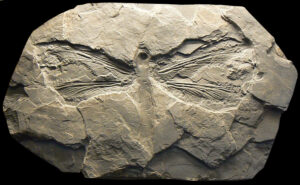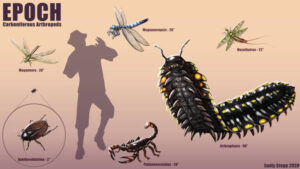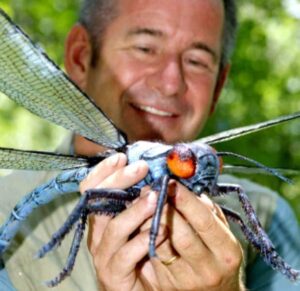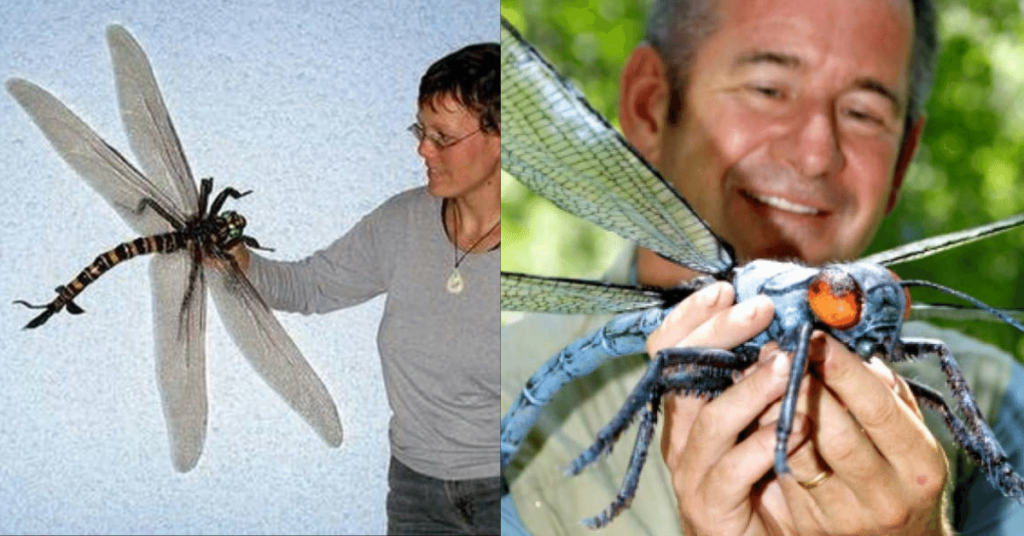An enormous representative of the extinct dragonfly-like order of griffinflies is the largest known insect species to have ever lived on Earth.

The largest living insect species we know today are the atlas moth (which sport the largest wings by surface area at 160 cm2 or 25 in2), the white witch moth (which has the largest wingspan at almost 30 cm or 12 in), and the goliath beetle, the heaviest insect at 115 g (4.1 oz).
As in the case of most other animal groups, the ancestors of insects also tended to be bigger than their contemporary counterparts. Among them, giant griffinflies such as Meganeura monyi and Meganeuropsis permiana are the largest known insect species to have ever existed. These creatures had a wingspan of some 75 cm (28 in) – about three times that of the atlas moth. Their maximum body mass is uncertain, with estimates varying between 34 g and 240 g, so up to more than twice the size of the goliath beetle.

When you step on a cockroach, there is that crunchy sound which some people find pleasing, while others detest. It is made by the squeezing and cracking of the exoskeleton, which is particularly hard in the case of cockroaches. In other insects, however, the exoskeleton is not always so hard, and different parts of the body may have varying solidity.

The most resilient body parts of griffinflies, on the other hand, are the wings, and so they are the parts that are most likely to be fossilized. Therefore, most fossil records of griffinflies consist of fragmentary specimens, with a few spectacular exceptions.
Griffinflies flew the skies of our planet for some 20+ million years during the Late Carboniferous and Late Permian periods around 317-247 million years ago, achieving a worldwide distribution. Their genus was fairly diverse, with new species regularly being described by scientists. Not all of them were so large though – some were within the size range of modern dragonflies. Others, however, were truly gigantic, even by dragonfly standards.
Meganeura monyi was the first griffinfly to be described, based on a single fossil wing about 12 inches long. It had an estimated wingspan of about 27 inches (about 68,5 cm) and was the largest insect known at the time of its description in 1895. In 1939, however, Frank Carpenter described Meganeuropsis permiana, based on an incomplete, but large, wing that was discovered in two parts. Carpenter estimated the wingspan of the newly found species to be 29 inches (almost 75 cm). Several years later, he described another new species of griffenfly, Meganeuropsis americana, with a wingspan similar to that of M. permiana. Today, specialists consider the two species of Meganeuopsis to be the same and stick with the name M. permiana. It is this species that holds the record as the largest known insect to have ever lived.

But why aren’t there such gigantic dragonflies in today’s world? What was that allowed griffinflies to attain their great size?
The Late Paleozoic period of Earth’s past was unusual in more than one way. During the Late Carboniferous and Early Permian there existed extensive coal swamp forests that created tremendous amounts of oxygen as a byproduct of photosynthesis. This created a hyperoxic atmosphere, with oxygen levels far in excess of modern levels.

Since they lack lungs, insects breath through a series of tubes (trachea) that are connected to the outside. Oxygen gets absorbed through the wall of these tubes by simple diffusion. With higher oxygen levels in the atmosphere, insects absorbed more of it, which would allow them to evolve giant body sizes. The anatomy of griffinflies hints at very maneuverable flight capabilities that are very demanding metabolically and require high oxygen levels.
In the Permian period, however, oxygen levels started to decrease, which was coupled with increasing aridity. Eventually, this could have led to the extinction of these giant insects. Modern atmospheric oxygen levels would be just too low to allow similar gigantism in active aerial predatory insects.
During the long period griffinflies existed, they actually ruled the air. Flying vertebrates like bats, birds, and pterosaurs would not evolve for at least another 100,000,000 years, so the skies were free of even more active fliers that could have preyed on them.
Please SHARE this story with your friends and family.



